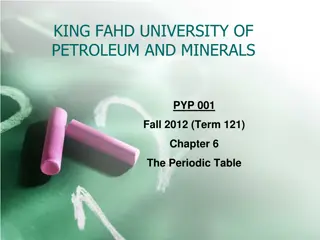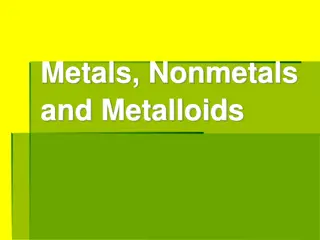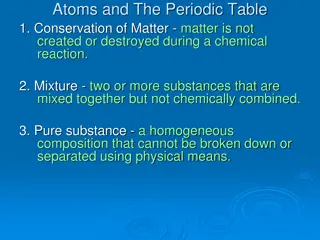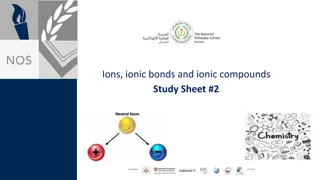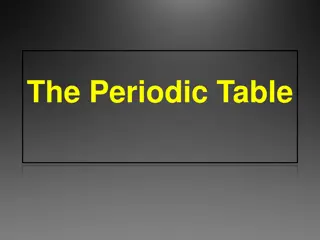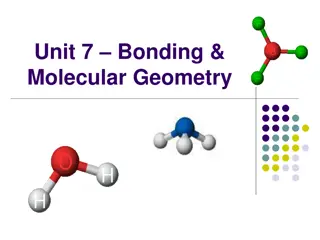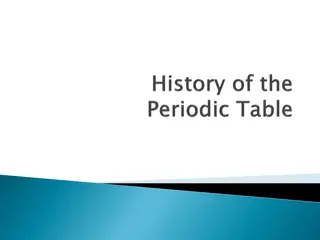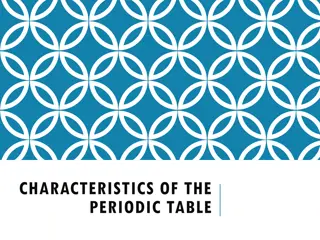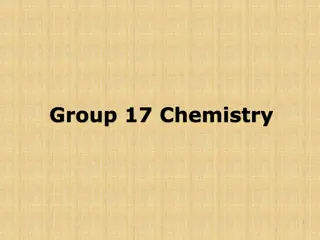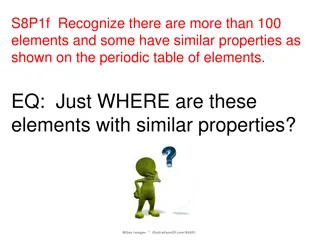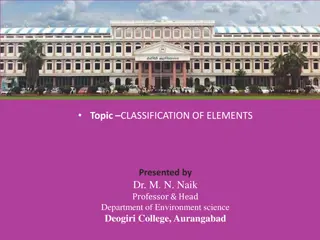Understanding the Periodic Table and Chemical Bonds in Physical Science
The periodic table organizes elements based on their properties, with rows representing periods and columns representing groups. Mendeleev's early table laid the foundation for predicting undiscovered elements. Today's periodic table orders elements by atomic number, showcasing the periodic law and
3 views • 15 slides
Understanding the Periodic Table: From Mendeleev to Modern Classification
Organizing elements based on their properties led to the development of the periodic table by Mendeleev with predictions that have stood the test of time. The modern periodic table arranges elements by increasing atomic number, showcasing repeating patterns of properties. It categorizes elements int
1 views • 29 slides
Understanding Valence Electrons and Ionic Charges in Elemental Bonding
Valence electrons play a crucial role in the formation of ions as elements combine. Nonmetals gain electrons to become negatively charged ions, while metals lose electrons to become positively charged ions. This process leads to the creation of electrically attractive elements open for bonding. The
0 views • 17 slides
Understanding the Periodic Table and Element Classification
The provided content discusses the development of the periodic table, periodic trends, and the classification of elements into metals, nonmetals, and metalloids. It covers key concepts like atomic radius, ionization energy, and properties of each element category, providing a comprehensive overview
1 views • 19 slides
Understanding Metals, Nonmetals, and Metalloids in the Periodic Table
Explore the characteristics and physical properties of metals, nonmetals, and metalloids. Learn about the differences in appearance, conductive abilities, malleability, ductility, and other key features of these elements. Discover why metals are excellent conductors of heat and electricity, while no
0 views • 18 slides
Understanding Atoms and the Periodic Table
Explore the fundamentals of atoms and matter, including the conservation of matter, mixtures, pure substances, and the properties of metals, metalloids, and nonmetals. Discover the significance of valence electrons, the neutral state of atoms, and the classification of elements on the periodic table
0 views • 13 slides
Understanding Ions, Ionic Bonds, and Ionic Compounds
Ions are charged particles formed by gaining or losing electrons, leading to the formation of ionic bonds between positively charged cations and negatively charged anions. The octet rule guides electron configurations, and the periodic table helps predict ion formation. Ionic bonding involves electr
0 views • 13 slides
Understanding Matter, Energy, Atoms, and Elements in Science
Explore the fundamental concepts of matter and energy, the structure of atoms, the properties of elements in the periodic table, and the classification of metals, nonmetals, and metalloids. Learn about compounds and mixtures and how they differ in composition and properties.
0 views • 22 slides
Understanding the Periodic Table: Metals, Nonmetals, and Metalloids
Delve into the characteristics of metals, nonmetals, and metalloids as you explore the layout of the periodic table. Discover how elements are grouped, their properties, and reactivity based on their placement. Uncover the significance of valence electrons, energy levels, and the distinct traits tha
0 views • 16 slides
Understanding Chemical Bonds and Molecular Geometry
Chemical bonds are the forces that hold atoms together, with valence electrons playing a crucial role. Ionic bonds involve complete electron transfer between metals and nonmetals, while covalent bonds see electrons being shared. Lewis dot diagrams help in visualizing the valence electrons of atoms,
0 views • 68 slides
Evolution of the Periodic Table: From Russian Chemist's Observations to Modern Classification
Russian chemist initially observed common properties in elements and arranged them by atomic mass, leading to the discovery of periodicity. English scientist later refined the arrangement by atomic number. The modern periodic table categorizes elements into groups with similar properties, based on a
0 views • 36 slides
Characteristics and Families of the Periodic Table: A Comprehensive Overview
Explore the characteristics of the periodic table including the alkali metals, alkaline earth metals, transition metals, lanthanides, actinides, and more. Learn about the properties, valence electrons, and uses of different groups, such as the boron group, carbon group, nitrogen group, oxygen group,
0 views • 8 slides
Understanding Group 17 Elements in Chemistry
Explore the properties, electron configurations, appearances, and industrial uses of Group 17 elements in the periodic table. Learn about nonmetals, metals, metalloids, and noble gases like fluorine, chlorine, bromine, iodine, and astatine. Discover the industrial production and reactions of hydroge
0 views • 20 slides
Understanding the Properties of Metals, Nonmetals, and Metalloids on the Periodic Table
Explore the distinctive properties of metals, nonmetals, and metalloids as depicted on the periodic table of elements. Discover where these elements with similar properties are located, compare their characteristics using a Venn diagram, and delve into their differences in terms of state, malleabili
0 views • 14 slides
Exploring the Nitrogen Family: Properties, Characteristics, and More
Delve into the Nitrogen Family, consisting of two nonmetals, metalloids, and a metal. Learn about their unique properties, electron configurations, atomic symbols, and ionic radii. Discover how ionization enthalpy and electronegativity vary within the group, shedding light on the behavior of these e
0 views • 11 slides
Understanding the Classification of Elements in the Periodic Table
In 1869, Mendeleev and Lothar Meyer published classification schemes for elements, leading to the development of the Periodic Table. This table organizes elements based on properties and reactivities, with each element having a unique atomic number. There are 92 naturally occurring and 13 man-made e
0 views • 31 slides



